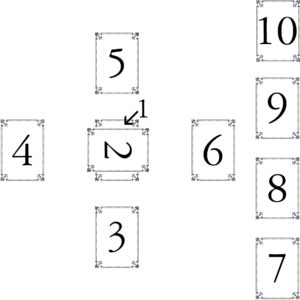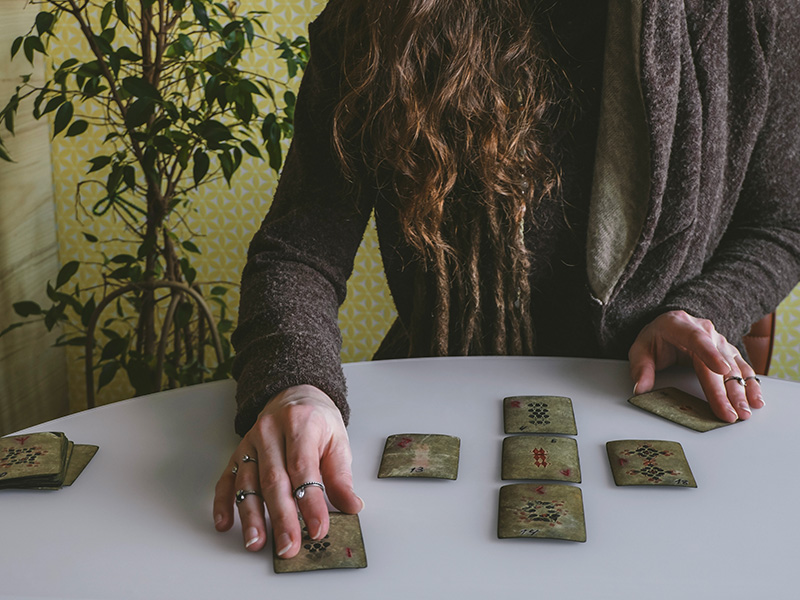The Celtic Cross
Welcome to another regular feature at The Fool’s Bag—the monthly spread! The fourth Monday of each month will be dedicated to a specific spread, spread type, or something else specifically spread-related. As this is our first Monthly Spread (that really needs a more clever title—I’m working on it!), I figured we should start with the most basic spread: The Celtic Cross.
If you’re a Tarot reader, you already know this spread—it was probably the first one you learned. If you’ve ever seen a Tarot reading on a TV show or in a movie, it was most likely this one, too. The Celtic Cross is, by far, the most standard, ubiquitous of all Tarot spreads.
And that’s for good reason—the Celtic Cross has a lot going for it. It’s ten cards; enough to cover a lot of territory without covering three table tops. And the shape the cards create when laid out make it an easy spread to learn and remember. So let’s get on with it, shall we?
History of The Celtic Cross Spread
This will be a short section because, really, we aren’t sure. This spread was first published in A.E. Waite’s book A Pictorial Guide to the Tarot, in 1910. He says in the book he believes that’s the first time it was published, but that it had been in use long before that. In fact, what he specifically said was that he knew the spread had never been published before “in connexion with Tarot cards,” suggesting it might be older than Tarot itself.
Layout of The Celtic Cross Spread
The Celtic Cross layout consists of two parts: the cross and the staff. The cross is formed by the first six cards, while the staff is represented by the remaining four cards. The appearance of the spread is always the same, but different sources lay out the cards in a different order, and there are some definite variations in how to interpret the different positions.
The positions and meanings below are what I use. They come, mainly, from books by Eden Gray, the first Tarot writer/teacher I read back in the day.

Card 1 – The Present. You can’t see it well in the image, but this is the card at the very center of the cross. This card represents the current situation or the central issue.
Card 2 – The Challenge. I learned the description of this card as being “what crosses” the first card. It’s an immediate obstacle or challenge you need to overcome in the situation described in card one.
Card 3 – The Past or the foundation – This is a situation or event, well in the past. It isn’t necessarily a part of the current issue, but it’s an experience you can draw on for information or wisdom.
Cards 4 and 5 – I like to explain these two together, because they’re closely related. (Again, not everybody uses the same meanings for all of these positions, and definitely not everyone reads these two cards in this way.) If you picture a circle drawn around each of these two cards, then you (or the person you’re reading for) is currently sitting in the space where those two circles overlap. Card 4 is an event or situation in the very recent past, something that’s still somewhat present, but moving into the past. Card 5 is a situation or event in the immediate future, likely so immanent its presence is already starting to be felt.
Card 6 – The Future. This is a possible, specific, future situation or event. How it relates to the main issue at hand can vary pretty widely from reading to reading; trust your intuition here.
Card 7 – Moving on to the staff, card 7 is you (or the querent you’re reading for), specifically in terms of the current issue.
Card 8 – External Influences. This is what people around you are thinking, saying or doing; it’s how outside factors are affecting the situation and your perception of it.
Card 9 – Internal Influences. This card is the querent’s hopes and fears. This card can reflect either your highest hopes or your worst fears. It’s very important, when reading for others, to explain this position before explaining the card, so the client isn’t confused by the meaning here. It’s also important, though, to remind the querent that thoughts are things, and thus their hopes can help them to manifest what they want while their fears can become real obstacles if not dealt with.
Card 10 – The Final Outcome. This card represents the final outcome of the situation, based on current influences and your actions.
Using The Celtic Cross Spread
What makes the Celtic Cross so popular is its usefulness. Ten cards makes it a bit larger than most basic spreads, but not so large as to make it unwieldy. All those card positions mean you can get deep into a complex situation, and have lots of cards to compare and contrast to help tease out meaning.
Another valuable thing about the Celtic Cross is that it’s an all-purpose spread. The different position meanings are generic and flexible, making this spread usable for most situations, as opposed to a spread designed specifically for relationship questions or for providing an astrological reading.
Indeed, a reader with only this spread and maybe one three-card spread under their belt is already well equipped to do effective readings. You could spend a whole career as a Tarot reader with no more than this one spread, really—but with so many other options, why would you ever do that?
Until Next Time
The Celtic Cross may be the most possible and, arguably, the most useful of all Tarot spreads… but it’s far from the only one! And so, that’s it for the Monthly Spread for April—see you next time!

